Addressing Peatland Rewetting in Russian Federation Climate Reporting
Abstract
1. Introduction
2. Materials and Methods
2.1. Rewetting in the Moscow Region
2.2. Determination of the Rewetted Areas
2.3. Emission Factors before Rewetting
2.4. GHG Emission Factors for Rewetted Areas
2.5. GHG Emissions Changes after Rewetting
2.6. Uncertainty Assessment
3. Results
3.1. Land Cover Changes after Rewetting in Radovitsky Mokh
3.2. GHG Emissions Reduction for Radovitsky Mokh
3.3. GHG Emissions Reduction for Regional and National Reporting
4. Discussion
Author Contributions
Funding
Institutional Review Board Statement
Informed Consent Statement
Data Availability Statement
Acknowledgments
Conflicts of Interest
References
- Joosten, H.; Sirin, A.; Couwenberg, J.; Laine, J.; Smith, P. The role of peatlands in climate regulation. In Peatland Restoration and Ecosystem Services: Science, Policy and Practice; Bonn, A., Allott, T., Evans, M., Joosten, H., Stoneman, R., Eds.; Cambridge University Press: Cambridge, UK, 2016; pp. 66–79. [Google Scholar] [CrossRef]
- Tubiello, F.N.; Biancalani, R.; Salvatore, M.; Rossi, S.; Conchedda, G. A worldwide assessment of greenhouse gas emissions from drained organic soils. Sustainability 2016, 8, 371. [Google Scholar] [CrossRef]
- Sirin, A.; Laine, J. Chapter 7: Peatlands and greenhouse gases. In Assessment on Peatlands, Biodiversity and Climate Change: Main Report; Parish, F., Sirin, A., Charman, D., Joosten, H., Minayeva, T., Silvius, M., Stringer, L., Eds.; Global Environment Centre: Kuala Lumpur, Malasia; Wetlands International: Wageningen, The Netherlands, 2008; pp. 118–138. [Google Scholar]
- Waddington, J.M.; Tóth, K.; Bourbonniere, R. Dissolved organic carbon export from a cutover and restored peatland. Hydrol. Process. 2008, 22, 2215–2224. [Google Scholar] [CrossRef]
- Sirin, A.; Minayeva, T.; Vozbrannaya, A.; Bartalev, S. How to avoid peat fires? Sci. Russ. 2011, 2, 13–21. [Google Scholar]
- Huang, X.; Rein, G. Downward spread of smouldering peat fire: The role of moisture, density and oxygen supply. Int. J. Wildland Fire 2017, 26, 907–918. [Google Scholar] [CrossRef]
- Sirin, A.; Maslov, A.; Makarov, D.; Gulbe, Y.; Joosten, H. Assessing wood and soil carbon losses from a forest-peat fire in the boreo-nemoral zone. Forests 2021, 12, 880. [Google Scholar] [CrossRef]
- Glukhova, T.V.; Sirin, A.A. Losses of soil carbon upon a fire on a drained forested raised bog. Eurasian Soil Sci. 2018, 51, 542–549. [Google Scholar] [CrossRef]
- Leifeld, J.; Wüst-Galley, C.; Page, S. Intact and managed peatland soils as a source and sink of GHGs from 1850 to 2100. Nat. Clim. Chang. 2019, 9, 945–947. [Google Scholar] [CrossRef]
- Blain, D.; Murdiyarso, D.; Couwenberg, J.; Nagata, O.; Renou-Wilson, F.; Sirin, A.; Strack, M.; Tuittila, E.-S.; Wilson, D.; Evans, C.D.; et al. Chapter 3: Rewetted organic soils. In 2013 Supplement to the 2006 IPCC Guidelines for National Greenhouse Gas Inventories: Wetlands; Hiraishi, T., Krug, T., Tanabe, K., Srivastava, N., Baasansuren, J., Fukuda, M., Troxler, T.G., Eds.; IPCC: Geneva, Switzerland, 2014; p. 41. Available online: https://www.ipcc.ch/publication/2013-supplement-to-the-2006-ipcc-guidelines-for-national-greenhouse-gas-inventories-wetlands/ (accessed on 29 September 2021).
- Leifeld, J.; Menichetti, L. The underappreciated potential of peatlands in global climate change mitigation strategies. Nat. Commun. 2018, 9, 1–8. [Google Scholar] [CrossRef]
- IPCC 2019. Climate Change and Land: An IPCC Special Report on Climate Change, Desertification, Land Degradation, Sustainable Land Management, Food Security, and Greenhouse Gas Fluxes in Terrestrial Ecosystems; Shukla, P.R., Skea, J., Calvo Buendia, E., Masson-Delmotte, V., Pörtner, H.-O., Roberts, D.C., Zhai, P., Slade, R., Connors, S., van Diemen, R., et al., Eds.; in press; Available online: https://www.ipcc.ch/srccl/ (accessed on 29 September 2021).
- Wilson, D.; Blain, D.; Couwenberg, J.; Evans, C.D.; Murdiyarso, D.; Page, S.E.; Renou-Wilson, F.; Rieley, J.O.; Sirin, A.; Strack, M.; et al. Greenhouse gas emission factors associated with rewetting of organic soils. Mires Peat 2016, 17, 1–28. [Google Scholar] [CrossRef]
- Günther, A.; Barthelmes, A.; Huth, V.; Joosten, H.; Jurasinski, G.; Koebsch, F.; Couwenberg, J. Prompt rewetting of drained peatlands reduces climate warming despite methane emissions. Nat. Commun. 2020, 11, 1644. [Google Scholar] [CrossRef]
- Granath, G.; Moore, P.A.; Lukenbach, M.C.; Waddington, J.M. Mitigating wildfire carbon loss in managed northern peatlands through restoration. Sci. Rep. 2016, 6, 28498. [Google Scholar] [CrossRef]
- Sirin, A.A.; Medvedeva, M.A.; Makarov, D.A.; Maslov, A.A.; Joosten, H. Multispectral satellite based monitoring of land cover change and associated fire reduction after large-scale peatland rewetting following the 2010 peat fires in Moscow region. Ecol. Eng. 2020, 158, 106044. (In Russian) [Google Scholar] [CrossRef]
- Minayeva, T.Y.; Bragg, O.M.; Sirin, A.A. Towards ecosystem-based restoration of peatland biodiversity. Mires Peat 2017, 19, 1–36. [Google Scholar] [CrossRef]
- Ahmad, S.; Haojie, L.; Günther, A.; Couwenberg, J.; Lennartz, B. Long-term rewetting of degraded peatlands restores hydrological buffer function. Sci. Total Environ. 2020, 749, 141571. [Google Scholar] [CrossRef] [PubMed]
- Bonn, A.; Reed, M.; Bain, C.; Chris, D.E.; Joosten, H.; Farmer, J.; Emmer, I.; Couwenberg, J.; Moxey, A.; Artz, R.; et al. Investing in nature: Developing ecosystem service markets for peatland restoration. Ecosyst. Serv. 2014, 9, 54–65. [Google Scholar] [CrossRef]
- Global Peatland Database. Available online: https://www.greifswaldmoor.de/global-peatland-database-en.html (accessed on 28 August 2021).
- Vomperskij, S.E.; Sirin, A.A.; Tsyganova, O.P.; Valyaeva, N.A.; Majkov, D.A. Peatlands and paludified lands of Russia: Attempt of analyses of spatial distribution and diversity. Izv. RAN Geogr. Ser. 2005, 5, 39–50. (In Russian) [Google Scholar]
- Vompersky, S.E.; Sirin, A.A.; Salnikov, A.A.; Tsyganova, O.P.; Valyaeva, N.A. Estimation of forest cover extent over peatland and paludified shallow peatlands in Russia. Contemp. Probl. Ecol. 2011, 4, 734–741. [Google Scholar] [CrossRef]
- Minayeva, T.; Sirin, A.; Bragg, O. (Eds.) A Quick Scan of Peatlands in Central and Eastern Europe; Wetlands International: Wageningen, The Netherlands, 2009; p. 132. Available online: https://www.wetlands.org/publications/a-quick-scan-of-peatlands-in-central-and-eastern-europe/ (accessed on 29 September 2021).
- Sirin, A.; Minayeva, T.; Yurkovskaya, T.; Kuznetsov, O.; Smagin, V.; Fedotov, Y.U. Russian federation (European part). In Mires and Peatlands of Europe: Status, Distribution and Conservation; Joosten, H., Tanneberger, F., Moen, A., Eds.; Schweizerbart Science Publishers: Stuttgart, Germany, 2017; pp. 589–616. [Google Scholar] [CrossRef]
- Tanneberger, F.; Tegetmeyer, C.; Busse, S.; Barthelmes, A.; Shumka, S.; Mariné, A.M.; Jenderedjian, K.; Steiner, G.M.; Essl, F.; Etzold, J.; et al. The peatland map of Europe. Mires Peat 2017, 19, 1–17. [Google Scholar] [CrossRef]
- Tanneberger, F.; Moen, A.; Barthelmes, A.; Lewis, E.; Miles, L.; Sirin, A.; Tegetmeyer, C.; Joosten, H. Mires in Europe—Regional diversity, condition and protection. Diversity 2021, 13, 381. [Google Scholar] [CrossRef]
- Panov, V.V. (Ed.) Perspective Use of Depleted Peat Bogs; Triada Publ.: Tver, Russia, 2013; p. 280. (In Russian) [Google Scholar]
- Sirin, A.A.; Minaeva, T.Y. Peatlands of Russia: Towards the Analysis of Sectoral Information; GEOS Publ.: Moscow, Russia, 2001; p. 190. (In Russian) [Google Scholar]
- Romanovskaya, A.A.; Korotkov, V.N.; Smirnov, N.S.; Karaban’, R.T.; Trunov, A.A. Land use contribution to the anthropogenic emission of greenhouse gases in Russia in 2000–2011. Russ. Meteorol. Hydrol. 2014, 39, 137–145. [Google Scholar] [CrossRef]
- Blain, D.; Row, C.; Alm, J.; Byrne, K.; Parish, F.; Duchemin, É.; Huttunen, J.T.; Tremblay, A.; Delmas, R.; Menezes, C.F.S.; et al. Agriculture, forestry and other land use. In IPCC Guidelines for National Greenhouse Gas Inventories; Chapter 7: Wetlands; Eggleston, H.S., Buendia, L., Miwa, K., Ngara, T., Tanabe, K., Eds.; IGES: Kanagawa, Japan, 2006; Volume 4, p. 24. Available online: https://www.ipcc.ch/report/2006-ipcc-guidelines-for-national-greenhouse-gas-inventories/ (accessed on 29 September 2021).
- IPCC. Refinement to the 2006 IPCC Guidelines for National Greenhouse Gas Inventories; Calvo Buendia, E., Tanabe, K., Kranjc, A., Baasansuren, J., Fukuda, M., Ngarize, S., Osako, A., Pyrozhenko, Y., Shermanau, P., Federici, S., Eds.; IPCC: Geneva, Switzerland, 2019; Available online: https://www.ipcc.ch/report/2019-refinement-to-the-2006-ipcc-guidelines-for-national-greenhouse-gas-inventories/ (accessed on 29 September 2021).
- Medvedeva, M.A.; Vozbrannaya, A.E.; Sirin, A.A.; Maslov, A.A. Capabilities of multispectral remote-sensing data in an assessment of the status of abandoned fire hazardous and rewetting peat extraction lands. Izv. Atmos. Ocean. Phys. 2017, 53, 1070–1078. [Google Scholar] [CrossRef]
- Suvorov, G.G.; Chistotin, M.V.; Sirin, A.A. The carbon losses from a drained peatland in Moscow oblast used for peat extraction and agriculture. Agrochemistry 2015, 11, 51–62. (In Russian) [Google Scholar]
- Joosten, H. The Global Peatland CO2 Picture; Wetlands International: Wageningen, The Netherlands, 2010; p. 35. Available online: https://www.wetlands.org/publications/the-global-peatland-co2-picture/ (accessed on 29 September 2021).
- Briefing Paper on the Role of Peatlands in the New European Union’s Common Agriculture Policy (CAP); Greifswald Mire Centre: Greifswald, Germany, 2019; Available online: https://greifswaldmoor.de/files/dokumente/Infopapiere_Briefings/GMC-briefing%20paper_CAP_final.pdf (accessed on 29 September 2021).
- Water Code of the Russian Federation 03.06.2006. No. 74-FZ (Red. ot 08.12.2020). The Law Came into Force 01.01.2021. Available online: https://policy.asiapacificenergy.org/node/826 (accessed on 29 September 2021). (In Russian).
- Sirin, A.A.; Maslov, A.A.; Valyaeva, T.A.; Tsyganova, O.P.; Glukhova, T.V. Mapping of peatlands in the Moscow oblast based on high resolution remote sensing data. Contemp. Probl. Ecol. 2014, 7, 809–815. [Google Scholar] [CrossRef]
- National Report on the Inventory of Anthropogenic Emissions by Sources and Removals by Sinks of Greenhouse Gases Not Regulated by the Montreal Protocol for 1990–2019. Part 2. Applications. Appendix 3.4 Information on the Rewetted Peatlands of the Russian Federation. Moscow, Russian, 2021; pp. 71–79. Available online: https://unfccc.int/documents/273477 (accessed on 29 September 2021). (In Russian).
- Hytteborn, H.; Maslov, A.A.; Nazimova, D.I.; Rysin, L.P. Boreal forests of Eurasia. In Coniferous Forests; Andersson, F., Goodall, D.W., Eds.; Ecosystems of the World: Amsterdam, The Netherlands; Elsevier: Amsterdam, The Netherlands, 2005; Volume 6, pp. 23–99. [Google Scholar]
- Barriopedro, D.; Fischer, E.M.; Luterbacher, J.; Trigo, R.M.; García-Herrera, R. The hot summer of 2010: Redrawing the temperature record map of Europe. Science 2011, 332, 220–224. [Google Scholar] [CrossRef] [PubMed]
- Konovalov, I.B.; Beekmann, M.; Kuznetsova, I.N.; Yurova, A.; Zvyagintsev, A.M. Atmospheric impacts of the 2010 Russian wildfires: Integrating modelling and measurements of an extreme air pollution episode in the Moscow region. Atmos. Chem. Phys. 2011, 11, 10031–10056. [Google Scholar] [CrossRef]
- Shaposhnikov, D.; Revich, B.; Bellander, T.; Bedada, G.B.; Bottai, M.; Kharkova, T.; Kvasha, E.; Lezina, E.; Lind, T.; Semutnikova, E.; et al. Mortality related to air pollution with the Moscow heat wave and wildfire of 2010. Epidemiology 2014, 25, 359–364. [Google Scholar] [CrossRef] [PubMed]
- Shaposhnikov, D.; Revich, B.; Bellander, T.; Bedada, G.B.; Bottai, M.; Kharkova, T.; Kvasha, E.; Lind, T.; Pershagen, G. Long-term impact of Moscow heat wave and wildfires on mortality. Epidemiology 2015, 26, 21–22. [Google Scholar] [CrossRef]
- Medvedeva, M.A.; Vozbrannaya, A.E.; Bartalev, S.A.; Sirin, A.A. Multispectral remote sensing for assessing changes on abandoned peat extraction lands. Earth Obs. Remote Sens. 2011, 5, 80–88. (In Russian) [Google Scholar]
- Medvedeva, M.A.; Vozbrannaya, A.E.; Sirin, A.A.; Maslov, A.A. Potential of different multispectral satellite data for monitoring abandoned fire hazardous peatlands and rewetting effectiveness. Mod. Probl. Remote Sens. Earth Space 2019, 16, 150–159. [Google Scholar] [CrossRef]
- Sirin, A.; Medvedeva, M.; Maslov, A.; Vozbrannaya, A. Assessing the land and vegetation cover of abandoned fire hazardous and rewetted peatlands: Comparing different multispectral satellite data. Land 2018, 7, 71. [Google Scholar] [CrossRef]
- Maslov, A.A.; Gul’be, A.Y.; Gul’be, Y.I.; Medvedeva, M.A.; Sirin, A.A. Assessment of the situation with the overgrowth of agricultural lands with forest vegetation on the example of the Uglich district of the Yaroslavl region. Sustain. For. Manag. 2016, 4, 6–14. (In Russian) [Google Scholar]
- Olofsson, P.; Foody, G.M.; Herold, M.; Stehman, S.V.; Woodcock, C.E.; Wulder, M.A. Good practices for estimating area and assessing accuracy of land change. Remote Sens. Environ. 2014, 148, 42–57. [Google Scholar] [CrossRef]
- Labutina, I.A. Interpretation of Remote Sensing Images: A Textbook for University Students; Aspekt Press: Moscow, Russia, 2004; p. 184. (In Russian) [Google Scholar]
- Chistotin, M.V.; Sirin, A.A.; Dulov, L.E. Seasonal dynamics of carbon dioxide and methane emission from a peatland in Moscow region drained for peat extraction and agricultural use. Agrochemistry 2006, 6, 54–62. (In Russian) [Google Scholar]
- Rydin, H.; Jeglum, J.K. The Biology of Peatlands; University Press: Oxford, UK, 2006; p. 162. [Google Scholar]
- Sirin, A.A.; Suvorov, G.G.; Chistotin, M.V.; Glagolev, M.V. Values of methane emission from drainage ditches. Environ. Dyn. Glob. Clim. Chang. 2012, 3, 1–10. (In Russian) [Google Scholar] [CrossRef][Green Version]
- Kravchenko, I.; Kizilova, A.; Menko, E.; Sirin, A. Methane cycling microbial communities in natural and drained sites of taldom peatland, Moscow region, Russia. Annu. Res. Rev. Biol. 2015, 6, 121–132. [Google Scholar]
- IPCC. Good Practice Guidance and Uncertainty Management in National Greenhouse Gas Inventories; Methodology Report; Penman, J., Kruger, D., Galbally, I., Hiraishi, T., Nyenzi, B., Emmanul, S., Buendia, L., Hoppaus, R., Martinsen, T., Meijer, J., et al., Eds.; IGES: Kanagawa, Japan, 2000; Available online: https://www.ipcc.ch/publication/good-practice-guidance-and-uncertainty-management-in-national-greenhouse-gas-inventories/ (accessed on 29 September 2021).
- Couwenberg, J.; Thiele, A.; Tanneberger, F.; Augustin, J.; Bärisch, S.; Dubovik, D.; Liashchynskaya, N.; Michaelis, D.; Minke, M.; Skuratovich, A.; et al. Assessing greenhouse gas emissions from peatlands using vegetation as a proxy. Hydrobiologia 2011, 674, 67–89. [Google Scholar] [CrossRef]
- Abel, S.; Haberl, A.; Joosten, H. A Decision Support System for Degraded Abandoned Peatlands Illustrated by Reference to the Peatlands of the Russian Federation; Michael Succow Foundation for Protection of Nature: Greifswald, Germany, 2011; pp. 1–52. [Google Scholar]
- IPCC 2018. An IPCC Special Report on the Impacts of Global Warming of 1.5 °C Above Pre-Industrial Levels and Related Global Greenhouse Gas Emission Pathways, in the Context of Strengthening the Global Response to the Threat of Climate Change, Sustainable Development, and Efforts to Eradicate Poverty; Masson-Delmotte, V., Zhai, P., Pörtner, H.-O., Roberts, D., Skea, J., Shukla, P.R., Pirani, A., Moufouma-Okia, W., Péan, C., Pidcock, R., et al., Eds.; in press; Available online: https://www.ipcc.ch/sr15/ (accessed on 29 September 2021).
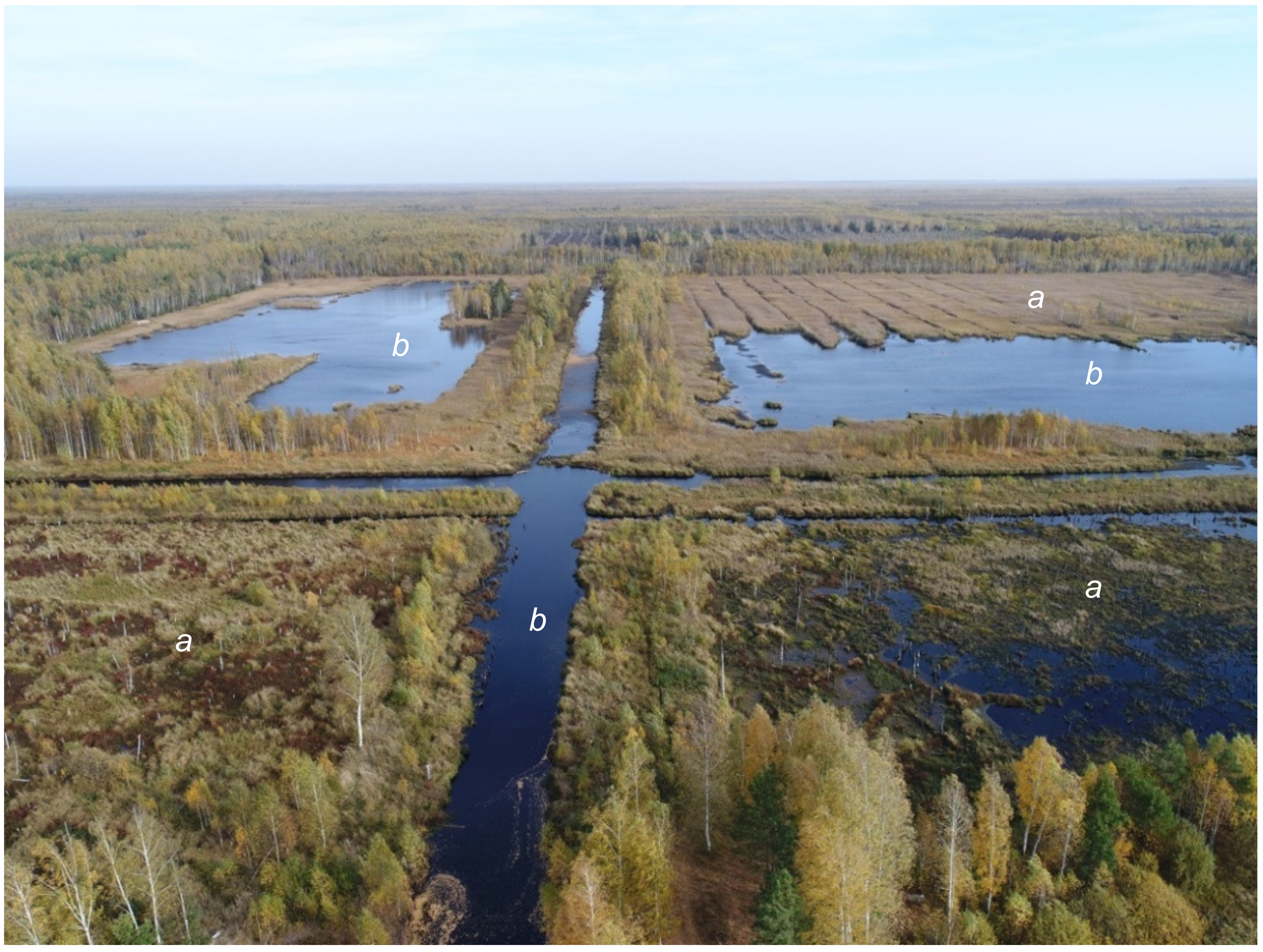

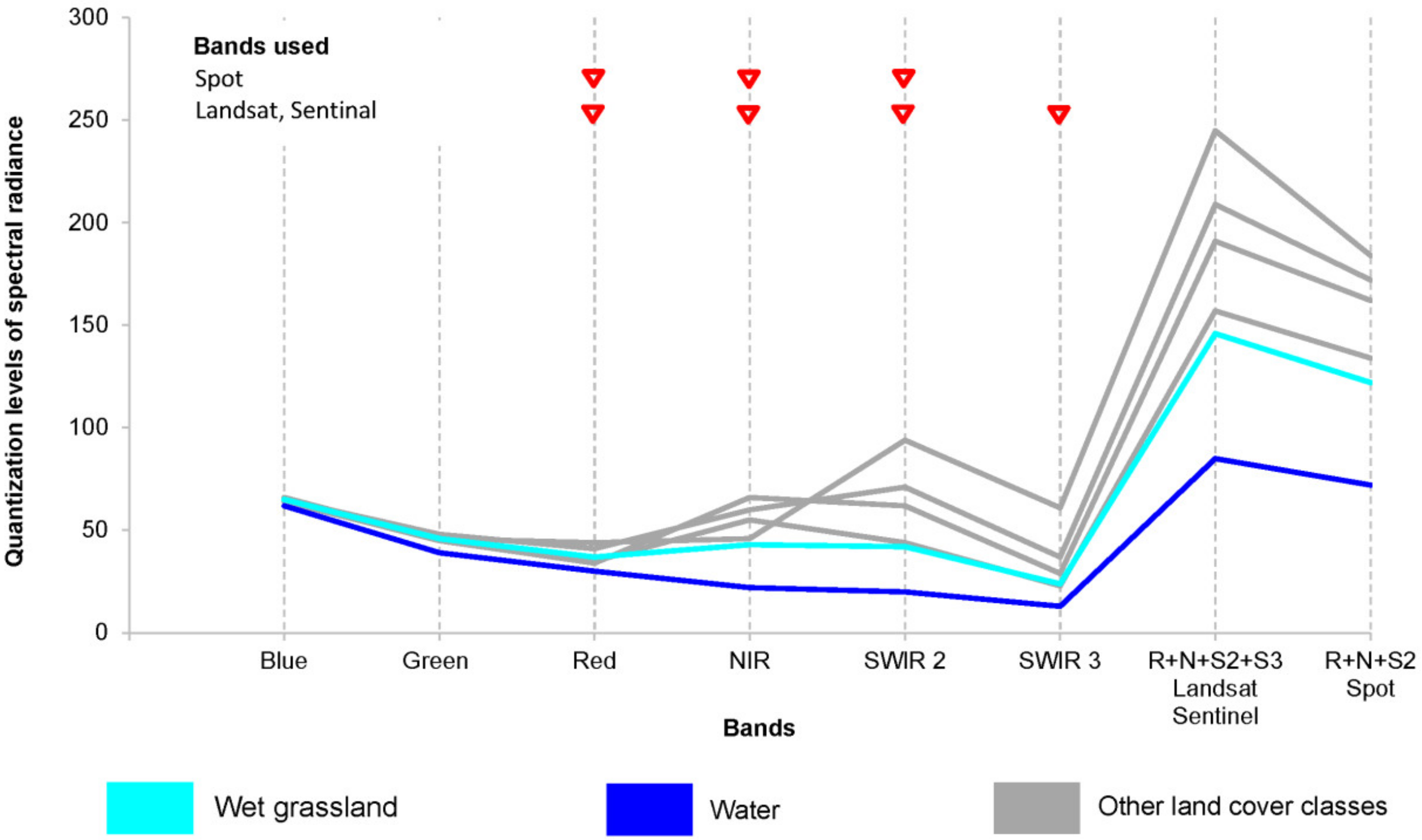
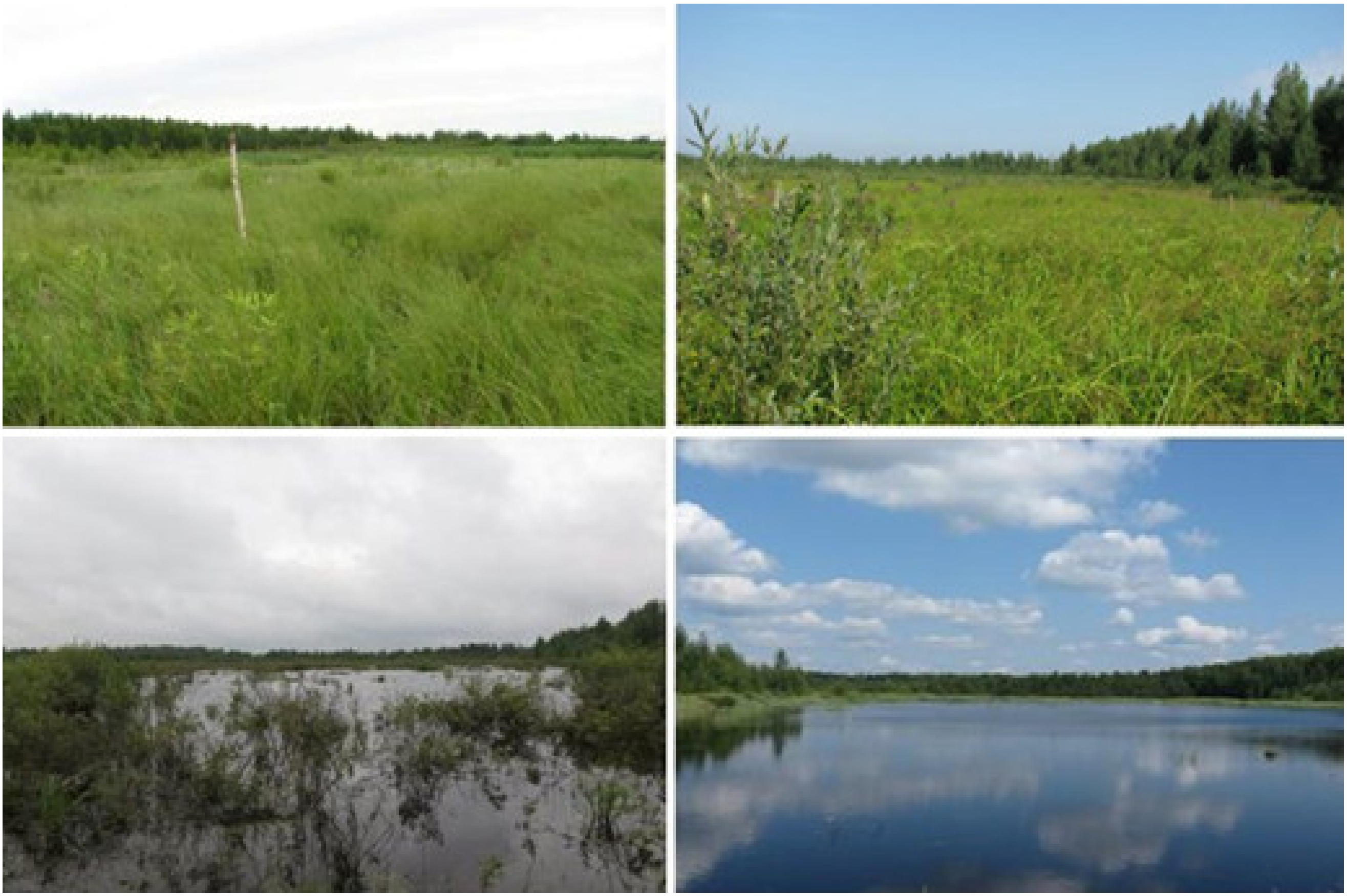
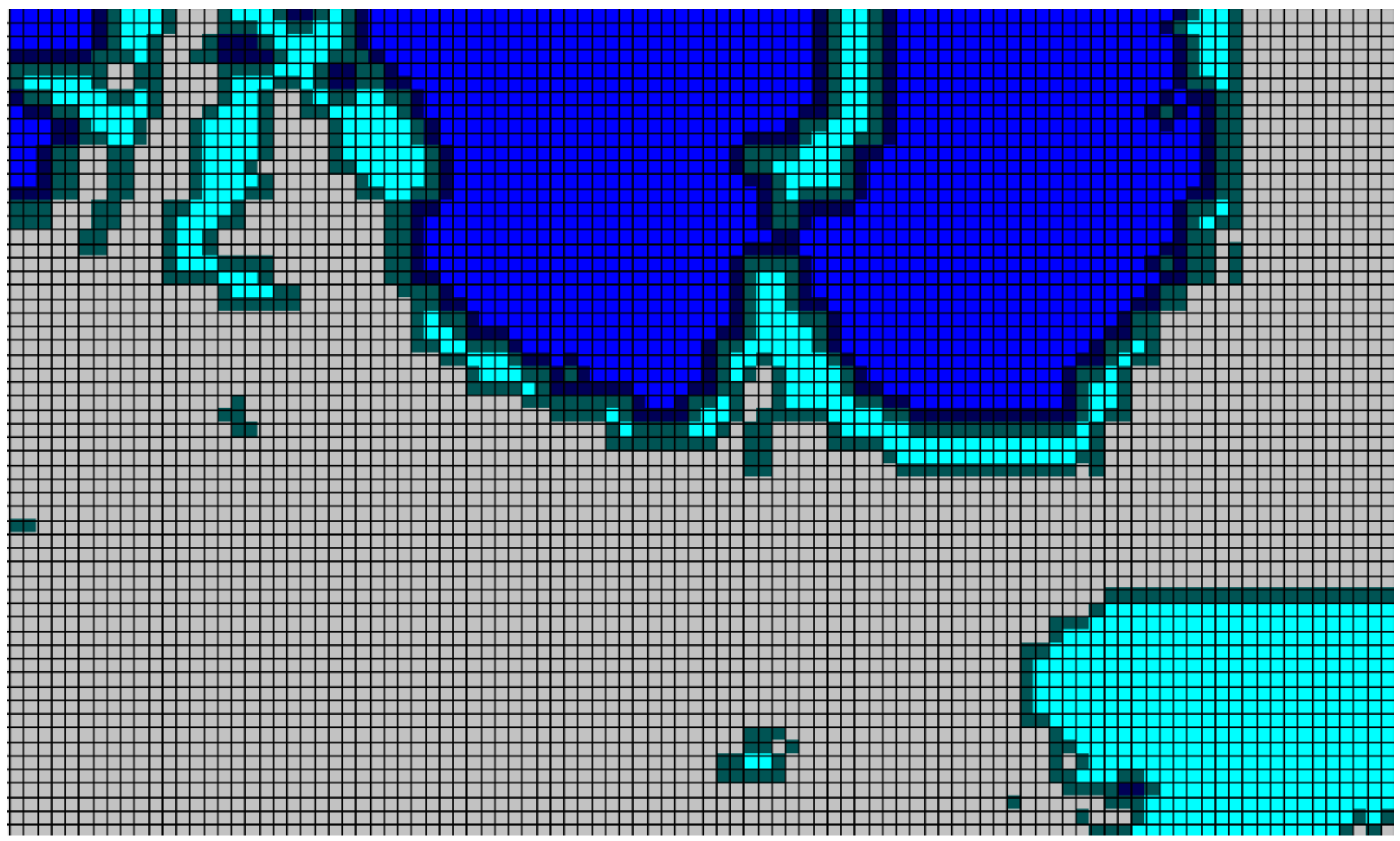
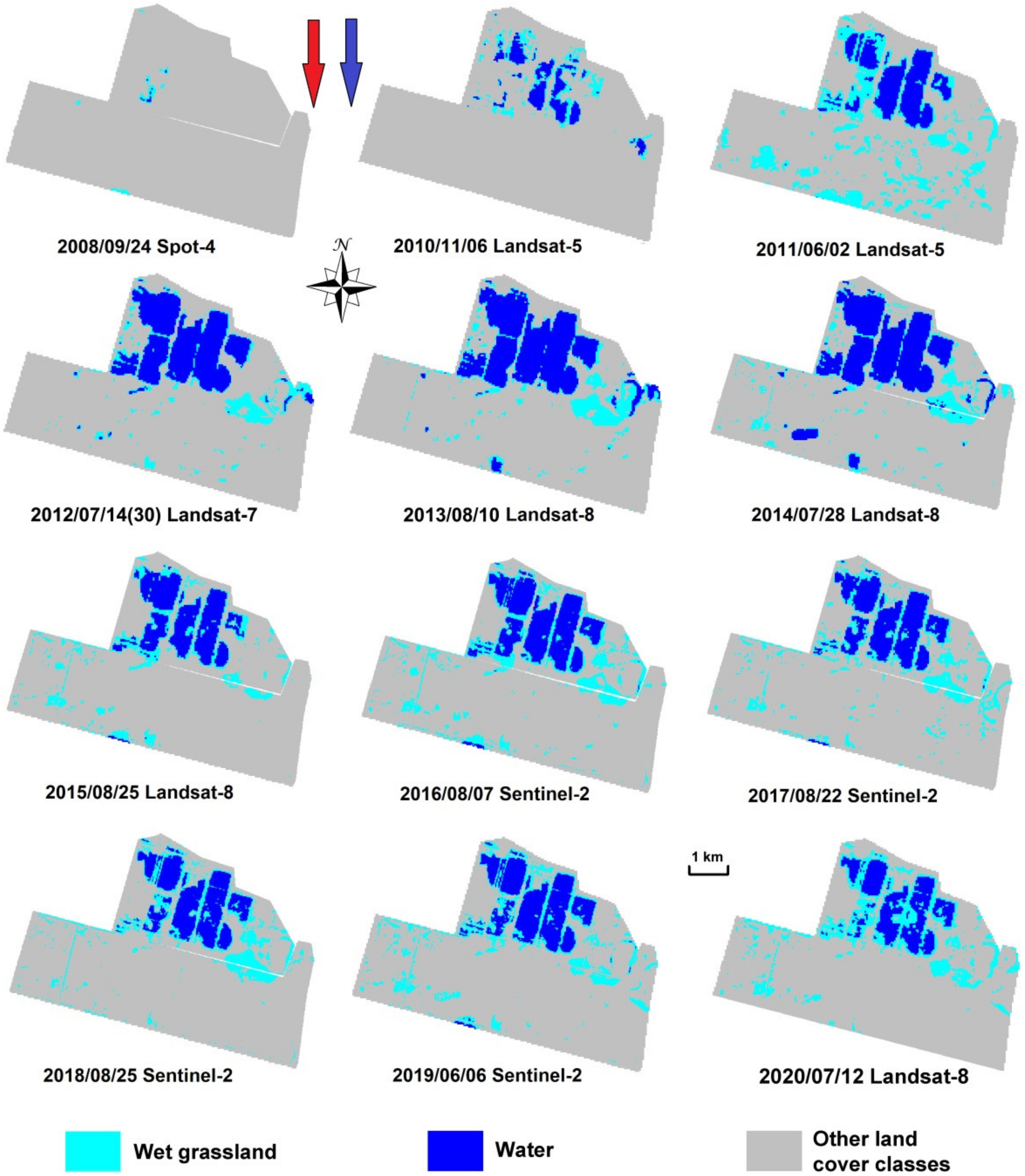
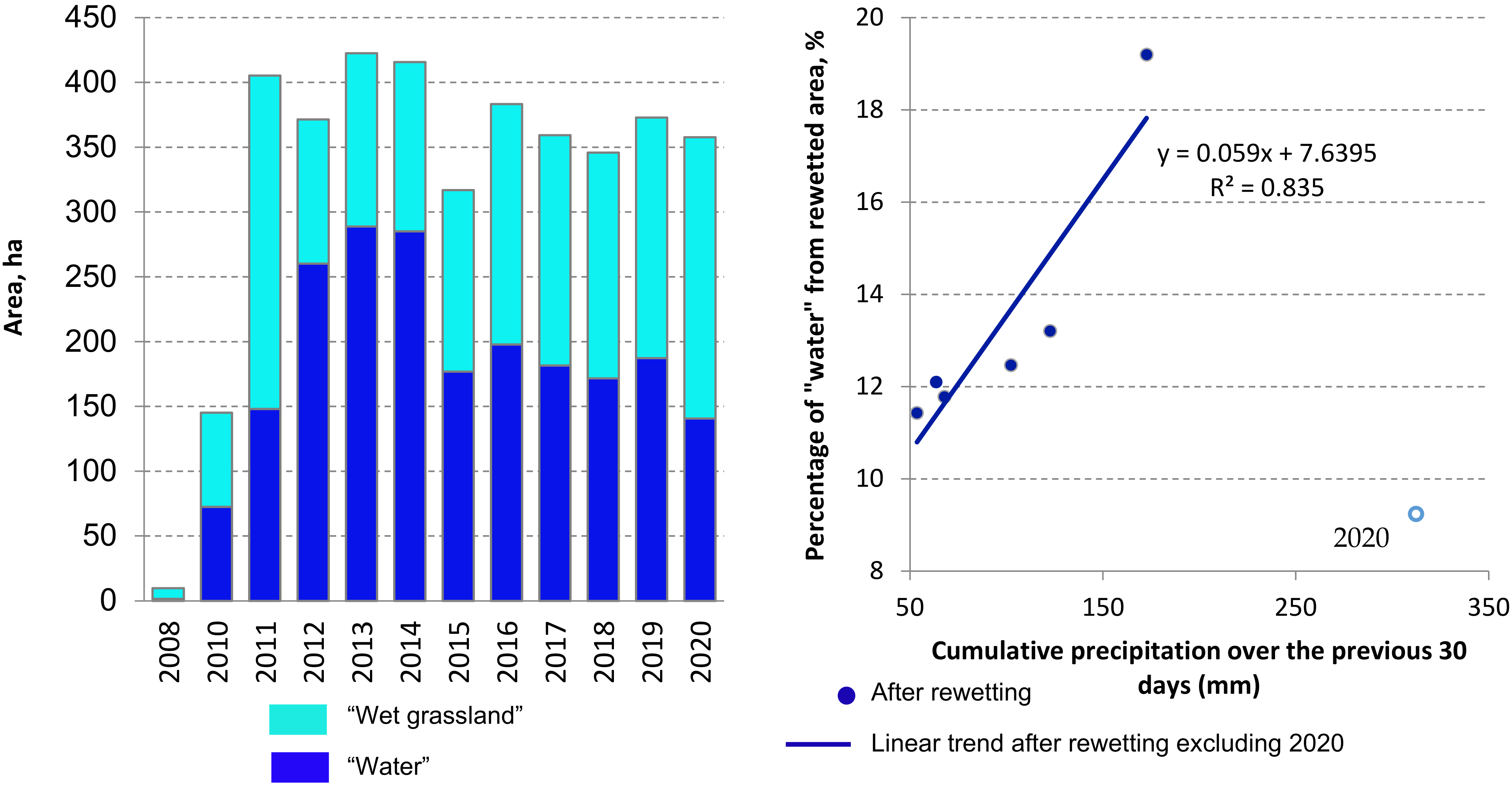
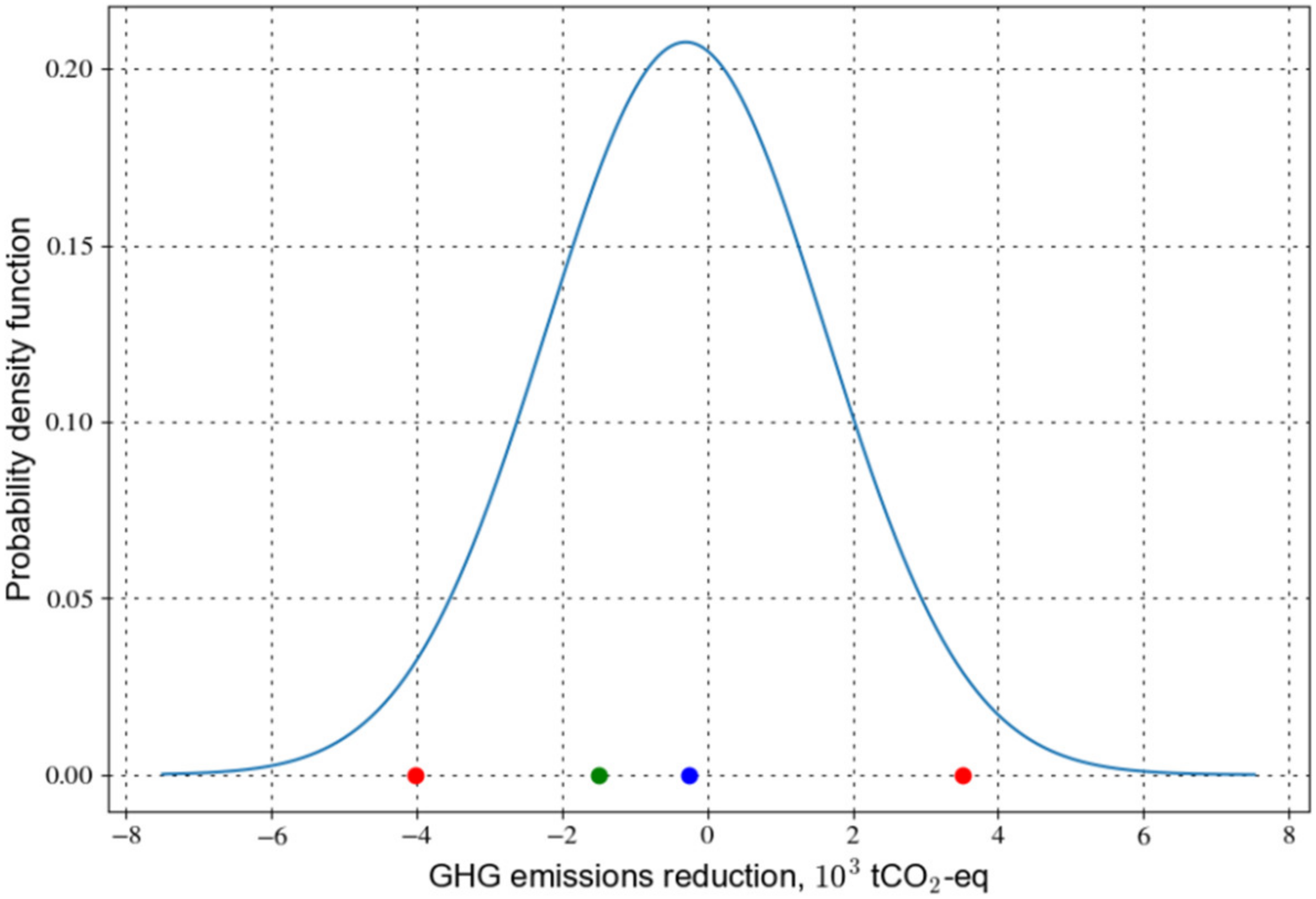

| Satellite/Ground Data | Hydrophilic Vegetation | Water Surfaces | Σ | User’s Accuracy | Producer’s Accuracy | Overall Accuracy |
|---|---|---|---|---|---|---|
| Hydrophilic vegetation | 26 | 1 | 27 | 96.3 | 100 | |
| Water surfaces | 0 | 27 | 27 | 100.0 | 96.4 | |
| Σ | 26 | 28 | 54 | 98.15 |
| Agent | Units | EF * (95% Confidence Interval) | Reference |
|---|---|---|---|
| CO2 | tCO2-C ha−1 yr−1 | 2.8 (1.1–4.2) ** | [10], Table 2.1 |
| DOC | 0.31 (0.19–0.46) *** | [10], Table 2.2 | |
| CH4 soil | kgCH4-C ha−1 yr−1 | 6.1 (1.6–11) ** | [10], Table 2.3 |
| CH4 ditch | 542 (102–981) ** | [10], Table 2.4 | |
| N2O | kgN2O-N ha−1 yr−1 | 0.3 (−0.03–0.64) ** | [10], Table 2.5 |
| Agent | Units | EF * (95% Confidence Interval) | Reference |
|---|---|---|---|
| ‘Rewetted organic soils‘ [10] | |||
| CO2 | tCO2-C ha−1 yr−1 | 0.50 (−0.71–1.71) ** | [10], Table 3.1 |
| DOC | 0.24 (0.14–0.36) *** | [10], Table 3.2 | |
| CH4 soil | kgCH4-C ha−1 yr−1 | 216 (0–856) ** | [10], Table 3.3 |
| CH4 ditch | 84.7 (78.8–90.6) **** | – | |
| N2O | kgN2O-N ha−1 yr−1 | negligible | [10], page 3.19 |
| ‘Flooded land’ [31] | |||
| CO2 | тCO2-C ha−1 yr−1 | 1.02 (1.00–1.04) **** | [31], Table 7.13 |
| DOC | 0 | – | |
| CH4 soil | kgCH4 ha−1 yr−1 | 84.7 (78.8–90.6) **** | [31], Table 7.15 |
| CH4 ditch | |||
| N2O | kgN2O-N ha−1 yr−1 | – | [31], page 7.24 |
| Agent | Units | EF * (95% Confidence Interval) |
|---|---|---|
| ‘Rewetted organic soils’ [10] | ||
| CO2 | tCO2-C ha−1 yr−1 | −2.3 (−4.4…−0.4) |
| DOC | −0.07 (−0.25…0.11) | |
| CH4 soil | kgCH4-C ha−1 yr−1 | 210 (1…434) |
| CH4 ditch | −457 (−837…172) | |
| N2O | kgN2O-N ha−1 yr−1 | −0.3 (−0.64...0.03) |
| ‘Flooded land’ [31] | ||
| CO2 | tCO2-C ha−1 yr−1 | −1.78 (−3.43…−0.41) |
| DOC | −0.31 (−0.50…0.15) | |
| CH4 soil | kgCH4-C ha−1 yr−1 | 78.6 (70.7…86.2) |
| CH4 ditch | −457 (−887.2…−27.4) | |
| N2O | kgN2O-N ha−1 yr−1 | −0.3 (−0.64...0.03) |
| Agent | Before Rewetting | After Rewetting | Emission Reduction |
|---|---|---|---|
| CO2 | 3.67 (−3…10) | 0.92 (−4…6) | 2.75 (−11…6) |
| DOC | 0.41 (−0.1…1.0) | 0.19 (−0.2…0.6) | 0.22 (0.9…0.5) |
| CH4 | 0.39 (−0.5…1.3) | 1.9 (−11…18) | −1.52 (−11…18) |
| N2O | 0.05 (−0.1…0.2) | 0 (0…0) | 0.05 (−0.2…0.1) |
| Total | 1.5 (−16…17) |
| Agent | “Wet Grassland” | “Water” | Total |
|---|---|---|---|
| 103 tCO2-eq yr−1 | |||
| CO2 | −47.6 (−250…160) | −16.9 (−65…35) | −64.5 (−270…150) |
| DOC | −1.4 (−20…16) | −2.9 (−8…1) | −4.4 (−23…14) |
| CH4 | 33.2 (−300…465) | 4.5 (−2…11) | 37.7 (−300…470) |
| N2O | −0.8 (−5…4) | −0.4 (−2…1) | −1.2 (−6…3) |
| Total | −32.3 (−415…460) |
Publisher’s Note: MDPI stays neutral with regard to jurisdictional claims in published maps and institutional affiliations. |
© 2021 by the authors. Licensee MDPI, Basel, Switzerland. This article is an open access article distributed under the terms and conditions of the Creative Commons Attribution (CC BY) license (https://creativecommons.org/licenses/by/4.0/).
Share and Cite
Sirin, A.; Medvedeva, M.; Korotkov, V.; Itkin, V.; Minayeva, T.; Ilyasov, D.; Suvorov, G.; Joosten, H. Addressing Peatland Rewetting in Russian Federation Climate Reporting. Land 2021, 10, 1200. https://doi.org/10.3390/land10111200
Sirin A, Medvedeva M, Korotkov V, Itkin V, Minayeva T, Ilyasov D, Suvorov G, Joosten H. Addressing Peatland Rewetting in Russian Federation Climate Reporting. Land. 2021; 10(11):1200. https://doi.org/10.3390/land10111200
Chicago/Turabian StyleSirin, Andrey, Maria Medvedeva, Vladimir Korotkov, Victor Itkin, Tatiana Minayeva, Danil Ilyasov, Gennady Suvorov, and Hans Joosten. 2021. "Addressing Peatland Rewetting in Russian Federation Climate Reporting" Land 10, no. 11: 1200. https://doi.org/10.3390/land10111200
APA StyleSirin, A., Medvedeva, M., Korotkov, V., Itkin, V., Minayeva, T., Ilyasov, D., Suvorov, G., & Joosten, H. (2021). Addressing Peatland Rewetting in Russian Federation Climate Reporting. Land, 10(11), 1200. https://doi.org/10.3390/land10111200








